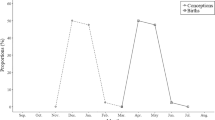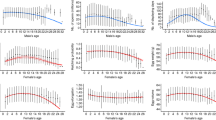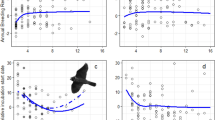Abstract
IN the wild state, the European badger (Meles meles L.) becomes pregnant once a year during a post-partum oestrus in February or March1. Fertilisation is followed, at the blastocyst stage of development, by a prolonged embryonic diapause which ends, when implantation occurs, in December or January. Implantation is thus delayed, for 10 months2 and it may be assumed, in accordance with Fries's hypothesis3, that the resumption of development in the winter is a genetically determined and adaptive phenomenon which results in birth during the spring when conditions for the young are most favourable. This pattern suggests that the time of implantation is related to some environmental factor such as photoperiod or temperature. To test this hypothesis, wild female badgers were captured in their set after fecundation and maintained during summer in conditions of ‘artificial winter’. We report here that in such conditions implantation, gestation and birth can be brought forward 4 months.
This is a preview of subscription content, access via your institution
Access options
Subscribe to this journal
Receive 51 print issues and online access
$199.00 per year
only $3.90 per issue
Buy this article
- Purchase on Springer Link
- Instant access to full article PDF
Prices may be subject to local taxes which are calculated during checkout
Similar content being viewed by others
References
Canivenc, R. & Laffargue, M. C.r. Soc. Biol. 150, 1193–1196 (1956).
Canivenc, R. C.r. Acad. Sci. hebd. Séanc. 246, 1914–1917 (1958).
Fries, S. Zool. Anz. 3, 486 (1880).
Bonnin, M., Canivenc, R. & Ribes, C. J. reprod. Fert. 52, 55–58 (1978).
Zuckermann, S. Ciba Fdn. Colloq. Endocr. 3, 213–228 (1952).
Sadleir, R. M. F. S. The Ecology of Reproduction in Wild and Domestic Mammals (Methuen, London, 1969).
Aulerich, R. S., Holcomb, L., Ringer, R. K. & Schaible, P. J. Q. Bull. Mich. State. Univ. agric. Exp. Stn 46, 132–138 (1963).
Belaiev, D. K., Klotchov, D. V. & Zhelova, A. J. Byull. mosk. Obshch. Ispyt, Prir., Otd Biol. 78, 107–125 (1963).
Allais, C. & Martinet, L. J. reprod. Fert. 54 137–143 (1978).
Enders, R. V. & Pearson, O. P. Am. Fur. Breeder 15, 18–19 (1943).
Canivenc, R., Bonnin-Laffargue, M. & Lajus-Boue, M. C.r. Acad. Sci. hebd. séanc. 264, 1486–1489 (1967).
Author information
Authors and Affiliations
Rights and permissions
About this article
Cite this article
CANIVENC, R., BONNIN, M. Delayed implantation is under environmental control in the badger (Meles meles L.). Nature 278, 849–850 (1979). https://doi.org/10.1038/278849a0
Received:
Accepted:
Issue Date:
DOI: https://doi.org/10.1038/278849a0
This article is cited by
-
Long-term monitoring of activities of badgers (Meles meles L.) in a broadleaved forest in France
European Journal of Wildlife Research (2021)
-
Evaluation of a single-shot gonadotropin-releasing hormone (GnRH) immunocontraceptive vaccine in captive badgers
European Journal of Wildlife Research (2019)
-
Lunar-related reproductive behaviour in the badger (Meles meles)
acta ethologica (2006)
Comments
By submitting a comment you agree to abide by our Terms and Community Guidelines. If you find something abusive or that does not comply with our terms or guidelines please flag it as inappropriate.



